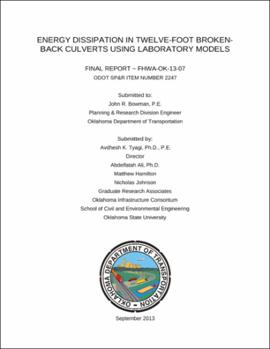| dc.creator | Tyagi, Avdhesh | |
| dc.creator | Ali, Abdelfatah | |
| dc.creator | Hamilton, Matthew | |
| dc.creator | Johnson, Nicholas | |
| dc.date.accessioned | 2018-03-01T20:50:07Z | |
| dc.date.available | 2018-03-01T20:50:07Z | |
| dc.date.issued | 2013-9 | |
| dc.identifier.govdoc | FHWA-OK-13-07 | |
| dc.identifier.other | Oklahoma Department of Transportation State Planning and Research item number 2247 | |
| dc.identifier.uri | https://hdl.handle.net/11244/54447 | |
| dc.description.abstract | This report represents Phase IV of broken-back culverts with a drop of 12 feet. The first phase of this research was performed with a drop of 24 feet, the second phase of this research was carried with for a drop of 6 feet, and the third phase of this research, performed was a drop of 18 feet. This research investigates the reduction in scour downstream of a broken-back culvert by forming a hydraulic jump inside the culvert. A broken-back culvert is used in areas of high relief and steep topography as it has one or more breaks in profile slope. A broken-back culvert in the laboratory represents a 1 (vertical) to 2 (horizontal) slope after the upstream inlet and then continuing 126 feet at a 1 percent slope in the flat part of the culvert to the downstream outlet. The prototypes for these experiments were either a two barrel 10-foot by 10-foot, or a two barrel 10-foot by 20-foot reinforced concrete culvert. The drop between inlet and outlet was selected as 12 feet. Three flow conditions were simulated, consisting of 0.8, 1.0 and 1.2 times the culvert depth. The Froude number (Fr1) of the hydraulic jump created in the flat part of the culvert ranged between 2.21 and 3.32. This Fr1 classifies the jump as an oscillating jump. The jump began nearly at the toe by placing sills in the flat part. For new culvert construction, the best option to maximize energy dissipation under open channel flow conditions is to use one 4.2-foot sill located 58.33 feet from the outlet. The maximum length of the culvert can be reduced from 45 feet to 58 feet. In pressure flow conditions, the optimal location was determined at a distance of 88 feet from the outlet for 2.5-foot sill. The length of the culvert can be reduced by 60 feet to 75 feet. Such a scenario is important where right-of-way problems exist for culvert construction. Also examined was a slotted sill which has a cut in the middle for cleanup purposes. In open channel flow conditions, the best option to maximize energy dissipation is to use one 5-foot slotted sill located 70 feet from the outlet. In the pressure flow conditions, the optimal slotted sill was 3.33-foot at a distance of 88 feet from the outlet. The regular and slotted sills contain two small orifices at the bottom to allow the culvert to completely drain. The impact of friction blocks was found to be minimal. No friction blocks were used to further dissipate the energy. In sedimentation experiments under regular and slotted sills, there was no sedimentation left. | |
| dc.format.extent | 146 pages | |
| dc.format.extent | 7,306,628 bytes | |
| dc.format.medium | application.pdf | |
| dc.language | en_US | |
| dc.relation.ispartofseries | No | |
| dc.relation.requires | Adobe Acrobat Reader | |
| dc.relation.uri | https://rosap.ntl.bts.gov/view/dot/31447/dot_31447_DS1.pdf | |
| dc.title | ENERGY DISSIPATION IN TWELVE-FOOT BROKEN-BACK CULVERTS USING LABORATORY MODELS (FHWA-OK-13-07) | |
| dc.type | Technical Report | |
| dc.description.version | Final Report, October 2012-September 2013 | |
| dc.description.peerreview | No | |
| dc.type.material | text | |
| dc.subject.keywords | Hydraulic jump | |
| dc.subject.keywords | broken-back culvert | |
| dc.subject.keywords | energy dissipation | |
| dc.subject.keywords | pressure flow | |
| dc.subject.keywords | open-channel flow | |
| dc.contributor.sponsor | Oklahoma Department of Transportation. Materials and Research Division. Office of Research & Implementation | |
